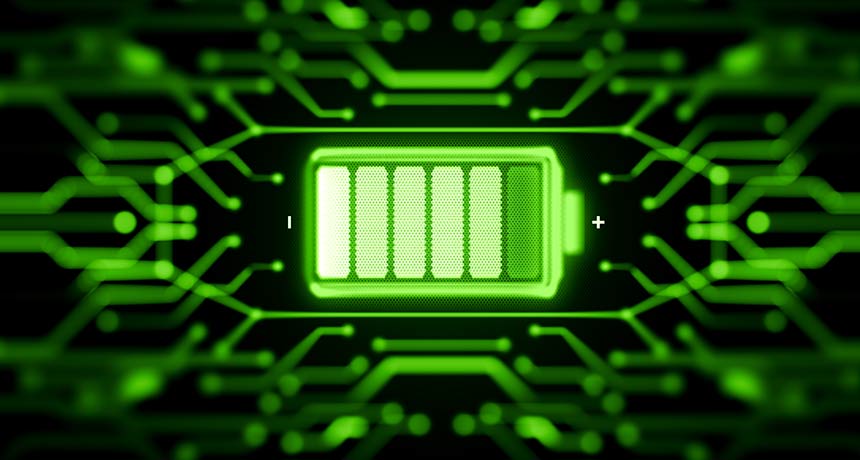Lithium-oxygen batteries are getting an energy boost
A new design could pack more energy and last longer than others of its kind

POWER UP A redesign of the lithium-oxygen battery could help these power cells pack more energy and withstand more recharge cycles.
MF3d/iStockphoto
- More than 2 years ago
A new type of lithium-oxygen battery could pack more energy and last longer than its predecessors.
Lithium-oxygen batteries, which are more energy-dense and made of more sustainable materials than typical lithium-ion cells, are promising candidates for the next generation of rechargeable batteries (SN: 1/21/17, p. 22). But lithium-oxygen batteries aren’t widely used yet because they die so quickly. By tweaking the building materials, researchers have now constructed a lithium-oxygen battery that can release nearly 100 percent of its stored charge and be recharged at least 150 times. This battery, described in the Aug. 24 Science, could one day become a more reliable, energy-dense power source for electric cars or other electronics.
Lithium-oxygen cells are made of two electrodes, an anode and a cathode, separated by a substance called electrolyte. When the battery is powering another device, oxygen molecules on the cathode combine with lithium ions from the electrolyte to form a solid compound called lithium peroxide. That chemical reaction releases energy. Recharging the battery breaks apart the lithium peroxide, returning oxygen and lithium to their starting positions.
But forging lithium peroxide generates several unwanted chemical by-products, which wastes energy. As a result, a lithium-oxygen battery may be able to deliver only about 80 percent of its stored electric charge to the device it’s powering. These pesky chemicals also damage the battery’s electrolyte and cathode, so the batteries often fail after only a few dozen recharges, says Larry Curtiss, a materials chemist at Argonne National Laboratory in Lemont, Ill., who was not involved in the work.
To build a better lithium-oxygen battery, chemist Linda Nazar of the University of Waterloo in Canada and colleagues replaced the typical organic electrolyte for an inorganic molten salt, and the standard carbon-based cathode for a metal-based one.
Written in crystal
In typical lithium-oxygen batteries, using the cell to power another device forms lithium peroxide crystals on the surface of the cathode (the hexagonal crystals shown in the scanning electron microscopy image, right). Discharging the new lithium-oxygen battery instead forms lithium oxide on the cathode (the octahedral crystals, left), allowing the battery to deliver more energy and last longer.

In this new battery, oxygen combines with lithium to create lithium oxide. This chemical reaction can store 50 percent more energy than the lithium peroxide reaction. As a result, the new design can make more energy-dense batteries than the previous setup. What’s more, lithium oxide doesn’t produce the troublesome chemical by-products that lithium peroxide does. That allows the new lithium-oxygen battery to release nearly all of its stored electric charge to other devices, and recharge more times than other lithium-oxygen cells.
These new batteries may eventually be used to power electric cars, but there is still “a ways to go before they can actually be used in vehicles,” Curtiss says. That’s because the new batteries have to be heated to at least 150° Celsius to work. “You’d have to find some way to heat this up when you start up the car,” he says.
Changing the substance used for the battery’s electrolyte may bring down its operating temperature, says Yang Shao-Horn, an energy and materials researcher at MIT whose commentary on the study appears in the same issue of Science. Such lithium-oxygen batteries could also serve as compact power sources for planes, spacecraft and submarines, she says.






